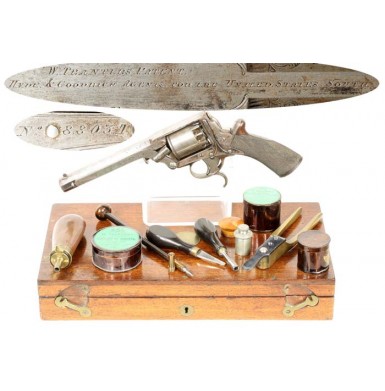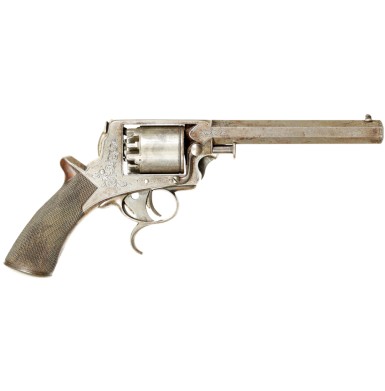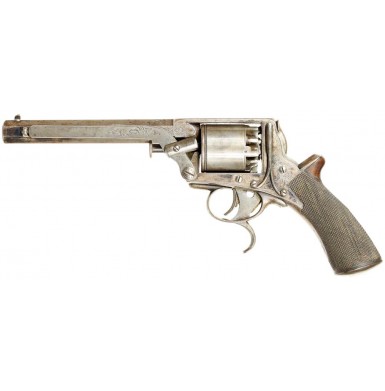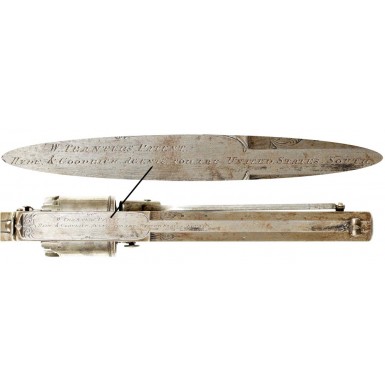Hyde & Goodrich Retailer Marked & Fully Cased Tranter
- Product Code: FHG-1982-SOLD
- Availability: Out Of Stock
-
$1.00
The revolvers produced by English gunmaker William Tranter were some of the most advanced and modern handgun designs to see use by the Confederacy during the course of the American Civil War. Tranter was born in 1816 and died in 1890, and during his working life he was one of the most prominent Gun, Rifle & Pistol Makers in the Birmingham (England) gun trade. He went into business for himself circa 1840, after completing his apprenticeship with Hollis Brothers & Co, which he had begun in 1830. Tranter continued in the trade until 1885, just five years before his death. In 1840, after spending a decade learning the gun trade at Hollis Bros & Co (later Hollis & Sheath), Tranter bought the established gun making business of Robert Dugard at 29 “ Whitehall Street. Over the next decade, he worked for himself and was also involved in joint ventures with his old employers John & Isaac Hollis as well as with Isaac Sheath. By 1850 he had located his primary business at 50 Loveday Street, where he was listed in a period directory as having “shops, sheds, steam machinery, yard & premises”. Tranter secured his first British patent related to firearms in October of 1849 when he registered a “pepperbox mechanism and lever catch for pistol locks”. In January 1853, he registered British Patent Number 212 (1853) for a pair of “self-cocking” pistol mechanisms and a safety mechanism. In December of the same year he registered designs for a double-action revolver mechanism, lubricated bullets and wadding, and a breech loading mechanism, all of which were covered by Patent Number 2921 (1853). In August of 1856 he registered the designs for a “double trigger revolver mechanism”, along with several other designs, all of which were covered by British Patent Number 1913 (1856). Tranter continued patenting firearm designs as late as 1887, even though he was no longer directly active in the gun trade.
Tranter’s most successful series of arms were his “self-cocking” revolvers, which were initially introduced in 1853. The earliest revolvers utilized Robert Adams’ patent for a solid, one-piece frame and barrel that were machined from a single forging. Tranter’s initial production run of revolvers included both Adams 1851 Patent lock works, and Tranter's own patented lock works. The original “Tranter” type revolvers, known to collectors as 1st Model Tranter revolvers had no provision for a fixed loading lever. The lever swiveled on a stud that projected from the left side of the frame, which had no provision to retain the lever when it was mounted on the revolver. The lever was intended to be stored in a case or carried in the pocket; hardly a practical solution if the user actually had to reload the revolver in the field. Most of these guns were manufactured on Adams Patent frames and have Adams Patent serial numbers (really patent tracking numbers to pay royalties to Adams) and these numbers are followed by a Y suffix. The 2nd Model Tranter revolvers also had a pin on the frame that allowed the attachment of a removable loading lever, but the pin had a small projection that allowed the lever to remain attached to the gun unless a notch in the lever was aligned with the stud projection to remove it. The later example of these guns, manufactured after about 1856, have Tranter Patent serial numbers and end with a T suffix. These guns not only include Tranter Patent lock works, but also a newly improved version of the Adams solid frame, which was patented by Tranter in 1856. At this point, Tranter revolvers rarely have Adams serial numbers. The 3rd Model Tranter revolvers had a more permanently attached loading lever, which was secured by a screw. The 3rd Models appear to have all been produced in the T suffix Tranter serial number range. All three of these models were based on his “double-trigger” system (initially referred to as his “hesitating mechanism” on the early production guns), which utilized a second “trigger” under the trigger guard to rotate the cylinder and cock the hammer. The trigger inside the triggerguard was used to trip the sear and release the hammer to fire the revolver. The 4th Model Tranter revolvers (which were introduced in 1856 and are all in the Tranter T-suffix series) used a single trigger, and utilized a lock work that would be referred to as a conventional “double action” mechanism today. All the Tranter revolver patterns were produced in a variety of calibers, with 54-Bore (.442) “Holster Size” and 120-Bore (.338) “Pocket Size” revolvers being the most commonly encountered calibers and frame sizes, and the mid-sized 80-Bore (.387) “Belt Size” being less often encountered. Some of the guns were also produced in the exceptionally large and powerful 36 and 38 bore sizes, which were larger versions of the holster size guns, and were about .50 caliber! Barrel lengths varied as well, with the larger caliber arms typically having longer barrels, and the smaller caliber guns having shorter barrel. All of the guns were 5-shot percussion revolvers, and typically featured checkered one-piece walnut grips, although smooth wooden grips and other grip materials are known to have been used on a special order basis.
The Tranter patent revolver was the primary competitor with the Adams and Adams-Beaumont patent revolvers in England, and was also exported widely. Pre-Civil War Tranter revolvers are known with US retailer marks, indicating that his designs were at least somewhat successful in the United States. The majority of the retailer marked guns are from the southern states, with the largest majority of them being marked by New Orleans retailers. Based upon extant examples, the firm of Hyde & Goodrich (later Thomas, Griswold & Co) appears to have been the primary importer of Tranter Patent revolvers into the southern United States. Most of these retailer-marked guns were sold cased with accessories, although some guns were certainly sold without the expensive casings and accouterments. During the course of the American Civil War, it appears that the importation of Tranter revolvers was somewhat limited, at least in terms of Confederate central government purchases. However, period advertisements in the south and extant examples with southern provenance make it clear that the guns were imported by blockade-runners as speculative items for sale in the south. Such famous Confederates as General John Hunt Morgan (3rd Model #3758T), General J.E.B. Stuart (4th Model #8673T), General John Magruder and Colonel Dabney H. Maury (3rd Model #7993T), who served on the staff of General Earl Van Dorn, all owned documented 54-Bore Tranter revolvers. The famous “Pratt Roll”, which lists the revolvers in the possession of Lt. Julian Pratt’s squad of troopers in Company H of the 18th Virginia Cavalry in July of 1864, lists two Tranter revolvers, with the serial numbers 15,465 and 15,476. This indicates that Tranter revolvers in the mid 15,XXX serial number range were in use by southern forces, and in the field by that time. While models are not listed in the list, it is generally assumed that these guns were either 3rd of 4th model revolvers and were likely 54-Bore. Other Tranter revolvers with southern provenance include guns which are retailer marked by T.W. Radcliffe of Columbia, SC. Additionally, a March 10, 1863 advertisement in the Richmond Times Dispatch for H. E. Nichols of Columbia, SC read in part:“Fine English Revolvers. Just received from England, six Tranter’s fine revolving pistols, 80 and 120 bore. Price $220 each”. All of this evidence indicates that at least some of the Tranter revolvers produced during (as well as prior to) the Civil War, saw Confederate use. Dating Tranter revolvers based upon their serial numbers is somewhat problematic, as frames were sometime produced in advance and the guns completed at a later date. What we do know is that the “T” serial number suffix came into use around serial number 2200, sometime between 1854 and 1856. We also know that Tranter produced revolvers using Adams patent serial numbers and a “Y” suffix from about 1853 through about 1856. These guns appear in several serial number ranges, as assigned by Adams, including the 2X,XXX range. All “Y” suffix guns predate the Civil War by at least four or five years. From extant examples of Tranters with specific presentations, dated invoices and dates of usage associated with them, it appears that those Tranter revolvers with serial numbers through about the 20,XXX range (and possibly some of the early guns in the 21,XXX range) with T suffixes appear to have been produced prior to the end of 1865, making them “Civil War era”. Post-Civil War southern retailer marks begin to appear in the 21,XXX range, suggesting that these guns are likely 1865 production, or possibly slightly later.
Offered here is an incredibly scarce, fully cased Hyde & Goodrich retailer marked 3rd Model Tranter Revolver in FINE condition. The retailer mark on this revolver is very desirable, and is one that is rarely found for sale. The topstrap is engraved in two lines:
W. TRANTER’s PATENT
HYDE & GOODRICH. AGENTS. FOR THE UNITED STATES SOUTH
Of the variations of Hyde & Goodrich retailer marks found on revolver, this is the most desirable and is believed by some to indicate that the gun was offered for sale sometime between the formation of the Confederacy (February 1861) and the close of Hyde & Goodrich’s retail operations (mid-1861), when the firm became Thomas, Griswold & Company. Hyde & Goodrich had been operating in New Orleans from about 1852, offering jewelry, silver and a variety of high-end imported and locally produced items ranging from household goods to fine English firearms. The full-sized revolver is 54-bore (approximately .442 caliber), and is contained in an original Tranter style casing with a full complement of original, period accessories. The pistol is engraved on the lower right side of the frame No 8,803 T, the serial number of the revolver. While Tranter’s cannot be dated specifically by serial number like Colt and Winchester firearms, based upon known extant examples that are identified or dated, I believe that this revolver was produced circa 1859, but due to the various delays associated with importing the gun, it may have been sold by Hyde & Goodrich as much as a year or more after its manufacture. I will also note that there are a small number of extant Hyde & Goodrich marked Tranter’s in the 8,XXX range (including one on display at the Confederate Memorial Hall museum in New Orleans), and it appears that the firm acquired a shipment of at least a couple dozen of the revolvers that were all produced circa 1858-1859, and marked with Hyde & Goodrich retailer information. The left side of the frame of the gun is not marked with the typical arced two-line TRANTER’s PATENT cartouche, which is commonly encountered on later production revolvers. However, this mark is present on the removable loading lever and on the left side of the trigger.
As noted above, the revolver is in about FINE condition. The gun is in extremely crisp condition with sharp edges and lines throughout. The gun retains only the tiniest traces of its original blued finish in protected areas, but still remains in wonderful condition. The metal has a mostly smooth pewter patina, with some lightly scattered patches of minor age discoloration, flecks of light surface oxidation and some lightly scattered pinpricking. The 6 ““ octagonal barrel bears the expected Birmingham commercial view and proof marks on the left angled flat, just in front of the frame juncture, as well as on the cylinder between the chambers. The cylinder appears to have been color case hardened, as were most Tranter cylinders of this period, and minute traces of darker mottling are visible on the otherwise pewter colored metal. The cylinder retains all its original cones (nipples), and they are all in crisp and fine condition with good edges and no significant battering or damage. The bore of the revolver rates about FINE as well, with sharp five-groove rifling. The bore is mostly bright and shows only some very light frosting, along with some scattered pinpricking and very light pitting along its length. The usual Tranter style, light foliate scroll engraving is present on the rear of the frame and at the frame to barrel junction. The cylinder shows boarder line engraving at its front and rear, which is also crisp and sharp, as does the muzzle and the loading lever. The left side of the frame retains the original Tranter’s patent spring safety that prevents the hammer from contacting the cones unless the trigger is pulled. Using the safety places the hammer on a pseudo “half cock” position, allowing the cylinder to be turned freely for loading. The original arbor pin retaining spring catch is also present on the forward right side of the frame. Both the safety and the arbor catch are in perfect mechanical condition and both retain large amount of their original brilliant fire blued finish with purple tones. The original, screw retained Tranter “3rd Model” loading lever is attached to the right side of the frame. The loading lever is marked with a two-line cartouche that reads: W. TRANTER’s / PATENT. The lever functions smoothly and locks securely into place when not in use. The original front sight is dovetailed in place near the muzzle as well. The one-piece checkered walnut grip is in about FINE condition as well, and matches the condition of the pistol perfectly. The grip is solid and free of any breaks, cracks or repairs. The checkering remains extremely sharp, but does show some light wear and minor handling marks. The action of pistol work very well and the revolver times, indexes and locks up, exactly as it should.
The pistol is contained within an original Tranter pattern English casing and is complete with a large number of period accessories. It is often impossible to be sure if the accessories with any cased pistol set are original to the casing, or if the case is original to the pistol. There is no maker or retailer label in the case to associate it directly with this gun, but the condition of the case and accessories are appropriate to the condition of the gun and the gun fits the case perfectly. There is no doubt that the case and the accessories are all original, period items and all are appropriate to the revolver. The casing is typical varnished English mahogany design with “Bible” hinges and a brass lock escutcheon on the front. The case is in about FINE condition and shows some wear and finish loss on the exterior. The case shows the expected scattered bumps, dings, minor surface mars and light scratches. The brass lock escutcheon is present in the front of the case, but the key is missing. The interior compartments are lined with a slightly faded green baize that shows good age and light wear, and appears to be absolutely original to the case. The case is in solid condition with no serious weakness to the structure itself or the interior compartment dividers. The case is loaded with wonderful Tranter revolver accessories, all of which are contained in compartments. Included in the casing are the following original accouterments:
1) Tranter Bullet Mould, in EXCELLENT condition. The mold is the typical 2-cavity brass mold found in many English casings, but casts two Tranter’s patent round nosed bullets with a single grease groove and shallow heel. The mold is marked 54 on the top of the sprue cutter, indicating 54-Bore. The left side of the mold is stamped with the usual two-line Tranter’s Patent cartouche. The brass body has a rich ocher patina that is untouched and uncleaned, and the mold cavities remain bright and clean with excellent edges. The blued sprue cutter is in wonderful condition, functions smoothly and retains about 80%+ of its original blue, which is fading and turning a plum-brown color.
2) Powder Flask in about FINE overall condition. The small bag shaped flask is of copper with a brass spout and top. The body of the flask retains some of its original protective varnish and shows only a few small bumps and dings. The polished brass top is clearly marked in three lines: JAMES DIXON / & SONS / SHEFFIELD. The original fire blued closure spring is in place on the top of the flask and retains most of its original finish. The flask remains fully functional.
3) Cap Tin in FINE condition. The tin is jappaned, and has the remains of a paper label that indicate that the caps are “made expressly for Tranter’s Patent revolvers”.
4) Pewter Oiler in EXCELLENT condition. The oiler is complete with the detail oiler attached to the inside of the lid. The bottom of the oiler is marked with the same three-line legend found on the flask: JAMES DIXON / & SONS / SHEFFIELD.
5) Tin of Bullets in FINE condition. Like the cap tin, it is jappaned and remains in FINE condition. The tin retains a fine original paper green label which is marked with Tranter’s information. Several Tranter’s patent round nosed bullets are contained in the tin.
6) Tin of Lubrication in FINE condition. This tin is also jappaned and remains in fine condition. The tin is partially full of lubricant and it retains a fine original green paper label as well, again with the correct Tranter markings and information.
7) Cleaning Rod in EXCELLENT condition. The wooden cleaning rod is in fabulous condition and shows only light handling marks and little use. The rod has a removable brass jag for cleaning the bore, and a brass mounted steel ball extractor (concealed by the jag) for unloading the cylinder. The rod appears to be of polished ebony with a rosewood knob at the end.
8) A small wooden container of lubricant in FINE condition. This is located in the small lidded compartment in the center of the case.
9) Cone Wrench in FINE condition. The wrench has an ebony handle and is the correct size for the cones in the revolver. It has a removable cone (nipple) pick in the base of the handle.
10) Turn Screw in FINE condition. The screwdriver has an ebony handle as well, and matches the cone wrench perfectly.
All of the accessories fit the casing perfectly and all have condition that is commensurate with the balance of the revolver.
Overall this is a really wonderful and scarce example of a Hyde & Goodrich retailer marked 3rd Model Tranter percussion revolver, in a very nice and complete casing. The gun is 100% complete, correct and original in every way and functions well. The accessories and the casing are really very nice and all of the accoutrements match the casing well. For any collector of secondary Confederate revolvers, this is about as good as it gets, with the most desirable of the Hyde & Goodrich retailer marks on a wonderful revolver imported for sale in New Orleans prior to the outbreak of the American Civil War.
SOLDTags: Hyde, Goodrich, Retailer, Marked, Fully, Cased, Tranter









